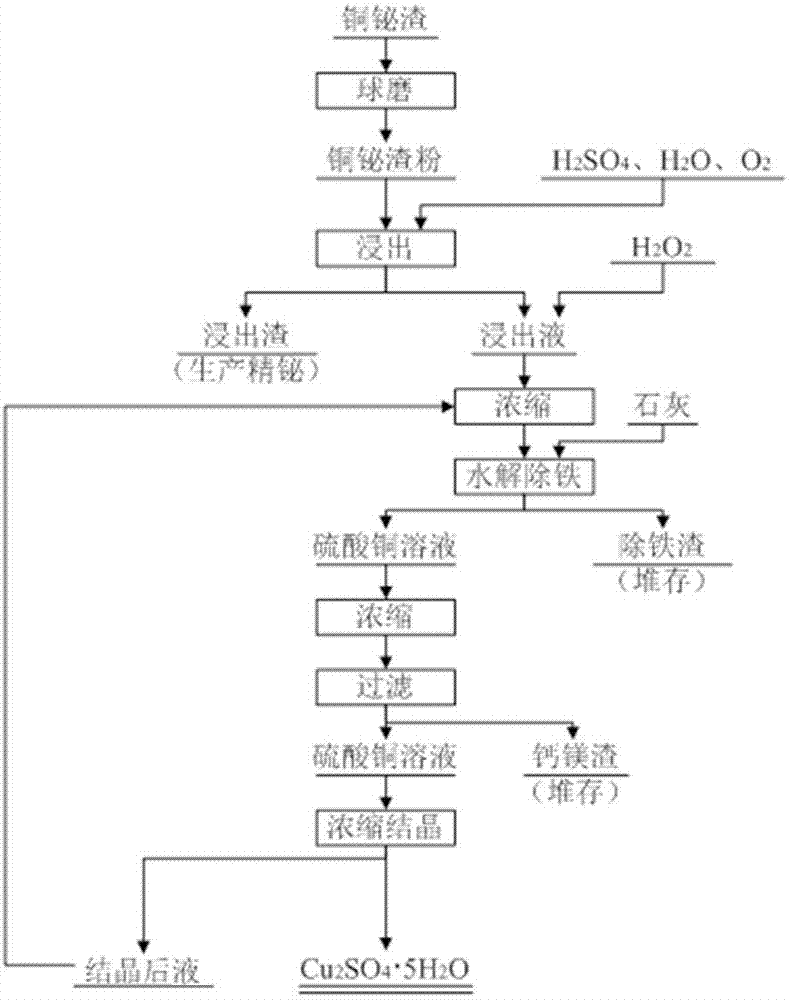Method for producing copper sulfate from copper-bismuth scum
A technology of copper bismuth slag and copper sulfate, applied in the chemical industry, can solve the problems such as the lack of comprehensive utilization of copper and bismuth to carry out technical research and other problems
- Summary
- Abstract
- Description
- Claims
- Application Information
AI Technical Summary
Problems solved by technology
Method used
Image
Examples
Embodiment 1
[0046] (1) Grind 1 ton of crushed copper-bismuth slag (Cu 15.0wt%, Bi35.0wt%, Ag1.0wt%) with a ball mill to a particle size of 200, and put it into a hopper for leaching.
[0047] (2) Mix the copper-bismuth slag powder obtained in step (1) with a dilute sulfuric acid solution containing 120g / l of sulfuric acid initial acid, according to the liquid-solid ratio of 3:1, and blow in oxygen, at a temperature of 70°C and an oxygen partial pressure of 0.3MPa , The total pressure is 0.9MPa, the leaching time is 3 hours, and the pH value of the end point is controlled to 1.5 to obtain the leaching material liquid, and the leaching material liquid is filtered at 85°C to obtain the leaching liquid and leaching residue respectively, the leaching rate is 77%, and the slag rate is 82%;
[0048] (3) Add 1% hydrogen peroxide to the leaching solution of the copper sulfate solution obtained in step (2) for 90 minutes to remove the Fe 2+ Oxidized to Fe 3+ , and then the solution was heated by s...
Embodiment 2
[0052] (1) Grind 10kg of crushed copper-bismuth slag (Cu 30.0wt%, Bi45.0wt%, Ag1.1wt%) with a ball mill to a particle size of 300, and put it into a hopper for leaching.
[0053] (2) Mix the copper-bismuth slag powder obtained in step (1) with a dilute sulfuric acid solution containing 150 g / l of initial sulfuric acid at a liquid-to-solid ratio of 7:1, and blow in oxygen, at a temperature of 85°C and an oxygen partial pressure of 0.5 MPa. , The total pressure is 1.6MPa, the leaching time is 6 hours, and the pH value of the end point is controlled to 2.5 to obtain the leaching material liquid, and the leaching material liquid is filtered at 80°C to obtain the leaching liquid and leaching residue respectively, the leaching rate is 84%, and the slag rate is 68%;
[0054] (3) Add 2% hydrogen peroxide to the leaching solution of the copper sulfate solution obtained in step (2) for 30 minutes to remove the Fe 2+ Oxidized to Fe 3+ , and then the solution was heated by steam at 80°C ...
Embodiment 3
[0058] (1) Grind 100g of broken copper-bismuth slag (Cu 35.0wt%, Bi30.0wt%, Ag1.4wt%) with a ball mill to a particle size of 400, and put it into a hopper for leaching.
[0059] (2) Mix the copper-bismuth slag powder obtained in step (1) with a dilute sulfuric acid solution containing 160g / l of sulfuric acid initial acid, according to the liquid-solid ratio of 8:1, and blow in oxygen, at a temperature of 80°C and an oxygen partial pressure of 0.4MPa , The total pressure is 1.2MPa, the leaching time is 4 hours, and the pH value of the end point is controlled to 2.0 to obtain the leaching material liquid. The leaching material liquid is filtered at 85°C to obtain the leaching liquid and leaching residue respectively. The leaching rate is 85% and the slag rate is 63.5%;
[0060] (3) Add hydrogen peroxide to the copper sulfate solution leaching solution obtained in step (2) to remove the Fe therein. 2+ Oxidized to Fe 3+ , and then the solution was heated by steam at 80°C and conc...
PUM
 Login to View More
Login to View More Abstract
Description
Claims
Application Information
 Login to View More
Login to View More - R&D
- Intellectual Property
- Life Sciences
- Materials
- Tech Scout
- Unparalleled Data Quality
- Higher Quality Content
- 60% Fewer Hallucinations
Browse by: Latest US Patents, China's latest patents, Technical Efficacy Thesaurus, Application Domain, Technology Topic, Popular Technical Reports.
© 2025 PatSnap. All rights reserved.Legal|Privacy policy|Modern Slavery Act Transparency Statement|Sitemap|About US| Contact US: help@patsnap.com

